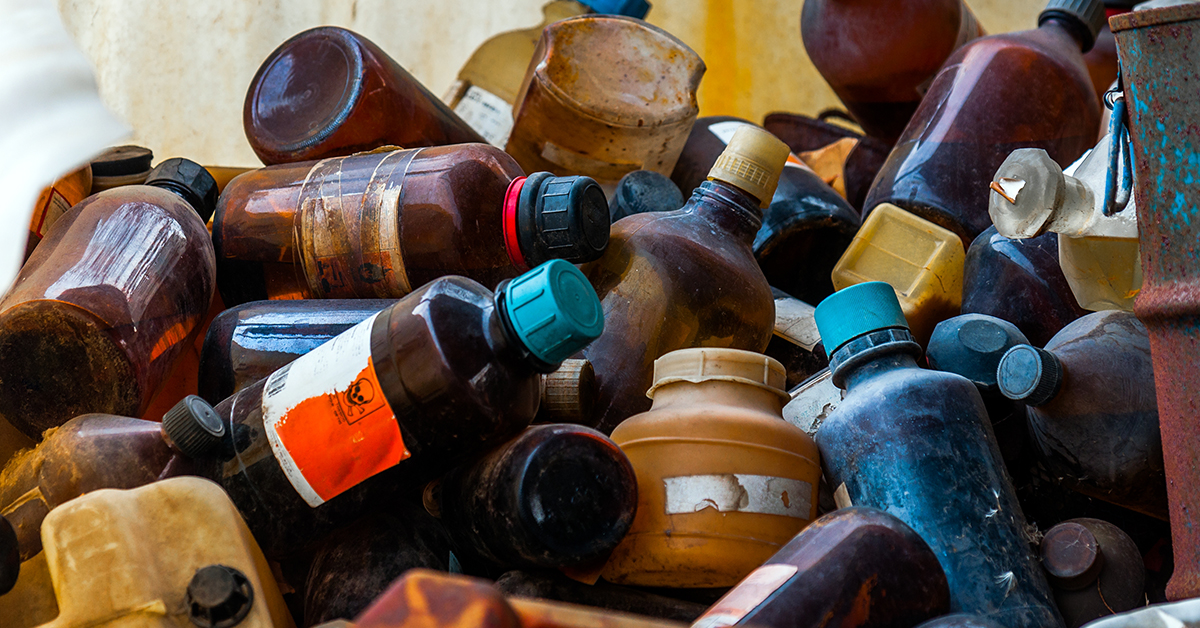by KenBay | Jun 6, 2024

Managing hazardous waste is a critical aspect of environmental protection and public health. This article explores the guidelines and regulations for managing hazardous waste, focusing on key aspects such as waste classification, generator status, tracking, consolidation, and disposal. Finally, we let you know how KenBay’s line of RotoPac industrial trash compactors can help your company dispose of its hazardous waste materials both efficiently, economically and legally.
(more…)
by KenBay | Sep 11, 2023

In today’s rapidly evolving industrial landscape, ensuring the safety and well-being of your staff should be a top priority. One crucial aspect of this ever-changing dynamic is creating and maintaining awareness about the proper handling and disposal of hazardous waste. Hazardous waste poses significant risks to human health, the ecological environment, and can result in legal and financial consequences if mishandled. In order to safeguard your employees and your business, it’s essential to establish and promote safety standards in the workplace. This article explores the importance of staff safety awareness regarding hazardous waste and offers guidance on achieving it effectively.
(more…)
by KenBay | Jun 23, 2023

Hazardous waste is defined by the EPA (Environmental Protection Agency) to be liquids, solids, gases or sludges. This blog will focus on the management of hazardous waste solids in the pharmaceutical industry. The EPA has a long-standing policy that non-prescription pharmaceuticals and other unsold retail items that have a reasonable expectation of being legitimately used/reused or reclaimed are not solid waste. This policy addresses the issues highlighted by a growing body of publicly available studies documenting the presence of pharmaceuticals in drinking and surface waters as well as their negative impacts to aquatic and riparian ecosystems.
(more…)
by KenBay | Mar 24, 2023

If a business or manufacturing facility is going to work at peak functionality and still abide by all environmental laws endemic to its location, it is necessary to first be fully aware of local industrial waste rules regulations. In the United States, most states take their cues and guidance from the Environmental Protection Agency (EPA) which sets the standard for the country at large. Rules are also applied at the state and municipal levels to better regulate industrial and hazardous waste.
The EPA regulates household, industrial, and manufacturing solid and hazardous wastes under the Resource Conservation and Recovery Act (RCRA). RCRA’s goals are to protect communities and citizens from the hazards of waste disposal; conserve energy and natural resources by recycling and recovery; reduce or eliminate waste; and clean up waste that may have spilled, leaked or been improperly disposed of.
(more…)
by KenBay | Jul 30, 2020

Aerospace Supplier Facility Management
As an industry leading Aerospace Supplier founded in 1979, we have built an excellent reputation within the aerospace sector by providing top notch quality and integrity for almost 40 years. Our philosophy is to provide a superior product by controlling growth and maintaining a sole focus on aerospace. Simply put, we are the “Standard of Excellence” within the aerospace metal finishing industry. Our commitment to the customer, qualified personnel and in-house quality guidelines have made us and will continue to make us a leader within its industry.
(more…)
by Kenbay Admin | Jun 6, 2019

Dealing with hazardous waste disposal can often seem overwhelming.
Not only are there a multitude of hazardous waste disposal rules and regulations to adhere to, but there are also serious consequences associated with any mishap.
The first step in creating a plan to dispose of hazardous waste is to assess your procedures that produce waste and consider how you might diminish their byproducts.
Here are five tips to make sure you’re handling hazardous waste disposal safely and efficiently.
(more…)
by timm | Oct 9, 2017
It All Started with a Cubic Yard Box
It won’t come as any surprise to most folks that bulk waste has high associated disposal costs. We’d like to share a story about a West Coast Aircraft Service Facility client of ours who serves the aircraft industry and the waste they produce is considered hazardous, which adds a whole additional level of complexity to the situation! The story begins with the switch to a Cubic Yard Box!
Jim Kirby supports a Paint Hangar Operations; the paint masking material contains chrome related primers and requires a Class 1 Fire Protection Unit. Their operations use a RotoPac® they rented from KenBay along with a 40 yard roll-off bin. The first round of compaction was done in 55 gallon metal drums, and shipped to their hazardous waste vendor in Tennessee for fuel blend. In addition, the larger materials would be compacted in the RotoPac and then shipped to a local waste vendor and then repackaged into a cubic yard box and ship to Tennessee for fuel blend. There were several associated costs with this approach, and as you can imagine, those costs quickly added up to a big expense.
One day their hazardous waste vendor made a change that sparked a huge savings for Jim’s company. They started requiring the waste be put into a hazardous waste rated cubic yard box instead of the drums and the cubic yard bags they had used historically. It was important to find the most efficient way to accommodate this change. Since there was already collaborative relationship with KenBay and they were already renting a RotoPac, it made sense to start with KenBay. Don Meis, the founder of KenBay spent time researching the new requirements and he presented a simple solution. There was a way to outfit the RotoPac so that it could compact waste directly into the cubic yard box.
The modification included the following:
- Remove the protection shield
- Stabilize the Unit to ensure the cubic yard box doesn’t move during compaction
- Use a shorter RotoPac drum
- Install guard rails to prevent the boxes from expanding as waste was compacted
That did the trick!
So their old process which required 55 gallon metal drums, a 40 yard roll-off bin, liners, transport to local waste vendor and finally shipping to Tennessee in a cubic yard box to fuel blend, was all reduced to onsite waste compaction indoors without exposing the environment to the hazardous waste, with better logistics, better security and lower costs!
We mentioned 83% savings. Can that be true? Let’s take a look at the numbers:
- For the first 6 months of 2015, the costs utilizing the 40 yard roll off and shipping to TN to fuel blend totaled $86,000
- For the second 6 months of 2015, the costs of using a customized RotoPac, compacting on-site and shipping to TN fuel blend totaled $14, 500
- An annual savings of $71,500!
The great part of this story is how they captured all associated costs and eventual savings as a result of making a few changes to their RotoPac compactor. How many of us pay the bills on a monthly basis without wondering how things could be done smarter and more cost effectively?
The costs for the old process came from various sources:
- 55 gallon metal drums
- The roll-off bin had to be kept outdoors, required a lid and regular maintenance and it took up a lot of physical space.
- Liners for the RotoPac
- Labor of transporting waste from paint operations to the outdoors where the 40 yard roll off was kept
- Pulls from the 40 yard roll-off bin cost $15 per pull and they averaged 10 pulls per year.
- Paying the hazardous waste vendor for the labor, fuel and materials required to put waste in a cubic yard box, blend and ship.
In 2016 Jim decided it was time to stop renting the RotoPac from KenBay and purchase it outright and he hasn’t looked back! Contact us at KenBay. Explain your specific sources of waste and we’ll recommend a process that is safe, efficient and cost effective. It would be our pleasure!
by CharlieB | May 16, 2017
 Got an old painting project that you haven’t done in a while? Maybe some old cans stored up in the garage that you haven’t used yet? What about if you’re involved in the manufacturing industry? Paint is certainly useful, but unused wasteful paint can actually be really harmful. Worse still, disposing of paint can get . . . complicated. So if you have some extra cans lying around, here’s some advice on how to get rid of old paint.
Got an old painting project that you haven’t done in a while? Maybe some old cans stored up in the garage that you haven’t used yet? What about if you’re involved in the manufacturing industry? Paint is certainly useful, but unused wasteful paint can actually be really harmful. Worse still, disposing of paint can get . . . complicated. So if you have some extra cans lying around, here’s some advice on how to get rid of old paint.
For this and other great waste removal tips, rely on KenBay to have the info you need. We commit ourselves to a zero-waste initiative, and encourage other companies to follow suit. visit KenBay’s website today and learn about our wide assortment of compactors available.
How to Get Rid of Old Paint (And Other Safety Tips)
-
Check what kind of paint it is
There’s basically two kinds of paint we’re concerned about: oil and latex. Latex is water based and very safe to store. Most of the paint you encounter for home use is latex based. Oil paint is highly toxic and flammable and should be handled with care. For these tips, we’ll be separating them into oil and latex categories.
-
Oil: Do NOT throw away in the trash
This is important with latex paint as well, but even more so for oil-based: do not just throw it away in the garbage! Oil paint could ignite easily and deal some serious fire damage to whoever is handling it.
-
Oil: Do not store for too long!
Equally as important: while you can store latex paint for a long time, oil paint will eventually reach an expiration limit. Once that occurs, it can emit dangerous toxic fumes.
-
Oil: Take to a proper facility which handles HHW.
Oil paint is classified as a HHW, which stands for Household Hazardous Waste. There are facilities specially handled to dispose of these kinds of materials. Find one in your local area to take your oil-based paint to.
-
Check your drop off-time
While you’re searching for an HHW disposal facility, make sure you check if there are any special regulated drop off or pickup times.
-
Latex: When Possible, Recycle Your Old Paint
Latex paint can be stored for a long time, but don’t let it go to waste on your shelf! It is possible to recycle old paint at special facilities. Find one in your local area! Or repurpose leftover paint for some other project. Perhaps there are some small toys in need a color touch up?
-
Latex: Donate to someone else in need.
If you can’t (or don’t want to) recycle your paint, see if someone else can use it!
-
Latex: If possible, move into a smaller jar or can.
If space is your main concern, it is perfectly fine to move your excess paint into a smaller mason jar or old soup can. Make sure you cover the lid completely with something like saran wrap so that it doesn’t dry.
-
Latex: Turn into a Dry Solid First
If you simply must dispose of your latex paint, don’t make a mess by pouring it into the trash. Instead, harden the paint first. Let it sit outside with the lid open and the sun will take care of the rest. After the paint is hardened, it is perfectly safe to throw out, along with the old can.
-
Latex: Mix with Newspaper or Cat Litter to Speed Dry
For the impatient among us, simply mix the old paint with shredded newspaper, sawdust, or cat litter. The material causes the paint to dry faster, and you will be able to dispose of it quicker.
We hope you found these tips on how to get rid of old paint useful! For non-paint related waste, trust KenBay to have the compactors you need. Our RotoPac can handle any major waste challenge with ease. If you want to experience one for yourself, you can try it before you buy it.
by CharlieB | Apr 15, 2017
 Let’s play a quick game. It’s called “Where Can I Throw Away My Chemical Waste?” Sound like fun? Oh hush, you know it does. So let’s start! So where can you throw away your chemical waste? In the garbage you say? Sorry, that’s the incorrect answer! Down the drain? Wrong again! Throw it out into the street? Are you even trying at this? Okay, okay, we’ll stop messing with you, you probably got our point. Proper chemical disposal is not only an environmental issue, it’s a general safety issue as well. You definitely want to make sure you’re following proper protocol. How do you know you are? Read on and find out.
Let’s play a quick game. It’s called “Where Can I Throw Away My Chemical Waste?” Sound like fun? Oh hush, you know it does. So let’s start! So where can you throw away your chemical waste? In the garbage you say? Sorry, that’s the incorrect answer! Down the drain? Wrong again! Throw it out into the street? Are you even trying at this? Okay, okay, we’ll stop messing with you, you probably got our point. Proper chemical disposal is not only an environmental issue, it’s a general safety issue as well. You definitely want to make sure you’re following proper protocol. How do you know you are? Read on and find out.
KenBay is a company committed to proper disposal of waste, chemical or otherwise. We believe in a zero-waste initiative and encourage other companies to do the same!
Why is Chemical Disposal Important?
Now, we assume if you’re worked in the manufacturing industry for a few years that you understand why proper chemical disposal is critically important. If that’s the case, feel free to skip down to the next paragraph. For everyone else, here’s what you need to know. Improper chemical disposal can have devastating effects on both people and the environment. If you just throw it out with the regular waste, you put sanitation workers at risk. When you flush it down the drain, you send it to a water treatment facility that probably isn’t made to handle it. Finally, if you just throw it outside, you risk causing incredible damage to the local environment. We know you don’t want to do any of these things, so what’s the right way to handle it?
First, Avoid Unsafe Practices
The first thing you need to ensure is that you’re not already disposing of waste improperly, even incidentally. Check through your practices for your workplace, including any chemical labs if that’s necessary. If you uncover any improper chemical disposal in your investigation, shut down that practice immediately.
Second, Conduct Research
The most important thing you can do is keep yourself informed about proper chemical disposal. We wish that it were as easy as saying “put chemicals here!” but that obviously isn’t the case. Different chemicals may require different disposal methods. Not to mention the different federal and state regulations that you also need to comply with. Those, obviously, may change depending on your location. A great resource to turn to is the Environmental Protection Agency website. The EPA is a valuable resource when it comes to waste management of any kind. One of the benefits here is that they offer a comprehensive breakdown of the Resource Conservation and Recovery Act, which covers hazardous waste disposal. If you’re looking to learn more about hazardous waste, this is a great place to start.
Once you’re up to date on your info, it will be easier to implement the state and federal practices to dispose of your chemical waste properly. And for all your waste disposal needs, you can rely on KenBay to help you and keep you informed. KenBay offers a wide assortment of waste compactors, including the HazPac for Hazardous Waste. If you want to experience KenBay for yourself, you can try us before you buy us. See for yourself the difference a good waste compactor can make.
by CharlieB | Feb 6, 2017
 We here at KenBay are all about the environment. We promote a zero waste initiative and encourage waste reduction whenever we can. If you are one of those people who agree that you need to do your part for the environment, then hey, we salute you! You may want to help encourage others to do their part as well. But how can you make a difference? It seems that waste is just such an ingrained part of our culture. Many people throw their garbage in landfills without giving it a second thought! Well, if you want your manufacturing plant to promote waste reduction, here are some great ways to get the ball rolling.
We here at KenBay are all about the environment. We promote a zero waste initiative and encourage waste reduction whenever we can. If you are one of those people who agree that you need to do your part for the environment, then hey, we salute you! You may want to help encourage others to do their part as well. But how can you make a difference? It seems that waste is just such an ingrained part of our culture. Many people throw their garbage in landfills without giving it a second thought! Well, if you want your manufacturing plant to promote waste reduction, here are some great ways to get the ball rolling.
Become Involved in the Community
They say that one person has the capability to bring about change. With enough determination, this is definitely possible. However, why stop at one? We think a better way would be giving that one guy a break and getting the entire community involved. As a major business, you definitely have the power! Perform a bit of research and learn about the environmental needs of your community. Perhaps the local park suffers from a littering problem. Or maybe the community generates too much waste. What are the causes of these issues?
Once you understand the issues, work with local leadership to help correct them! Organize and fund park clean up day, for example, or set up recycling bins around high traffic areas to encourage recycling and waste reduction over landfill use. Also, think about setting up events that educate the public on what they can do at home and at work to help the environment. Also, consider donating to a non profit or charity that you think makes a difference. What takes one person a lot of effort to do by himself, an entire community can do easily! Not to mention it gets your company a lot of great press.
Become an Example for Others
Another great way to encourage waste reduction is to be an example of it yourself. This isn’t always easy, but with a little extra effort, you will find responsible waste management is definitely doable. Track your material flow and learn where your products come from . . . and where they go. Ensure that you are doing everything you can to recycle your materials, and look into options like waste to energy to see if it’s feasible for you. Finally, make sure that switching to an environmentally conscious mindset isn’t slamming your finances. Use a solid compactor and reduce your spending on the labor and hauling of your waste.
As it so happens, KenBay compactors are exactly the thing you need to promote fantastic waste reduction! Our compactors are small and portable, and you can use them right at the source of your waste. Simply toss it in and forget about it! Additionally, our RotoPacs continuously press and compress the waste into a cube shape, which is easier to haul and transport. You won’t have to waste money hauling empty space on the truck, and you’ll have fewer trips overall! If you are interested in experiencing a KenBay RotoPac for yourself, we offer you the option to Try it Before you Buy it! If you like what you have, just pay for the one we already sent you and be done with it. If you want to promote more waste reduction, trust KenBay to have your back!









 Got an old painting project that you haven’t done in a while? Maybe some old cans stored up in the garage that you haven’t used yet? What about if you’re involved in the manufacturing industry? Paint is certainly useful, but unused wasteful paint can actually be really harmful. Worse still, disposing of paint can get . . . complicated. So if you have some extra cans lying around, here’s some advice on how to get rid of old paint.
Got an old painting project that you haven’t done in a while? Maybe some old cans stored up in the garage that you haven’t used yet? What about if you’re involved in the manufacturing industry? Paint is certainly useful, but unused wasteful paint can actually be really harmful. Worse still, disposing of paint can get . . . complicated. So if you have some extra cans lying around, here’s some advice on how to get rid of old paint. Let’s play a quick game. It’s called “Where Can I Throw Away My Chemical Waste?” Sound like fun? Oh hush, you know it does. So let’s start! So where can you throw away your chemical waste? In the garbage you say? Sorry, that’s the incorrect answer! Down the drain? Wrong again! Throw it out into the street? Are you even trying at this? Okay, okay, we’ll stop messing with you, you probably got our point. Proper chemical disposal is not only an environmental issue, it’s a general safety issue as well. You definitely want to make sure you’re following proper protocol. How do you know you are? Read on and find out.
Let’s play a quick game. It’s called “Where Can I Throw Away My Chemical Waste?” Sound like fun? Oh hush, you know it does. So let’s start! So where can you throw away your chemical waste? In the garbage you say? Sorry, that’s the incorrect answer! Down the drain? Wrong again! Throw it out into the street? Are you even trying at this? Okay, okay, we’ll stop messing with you, you probably got our point. Proper chemical disposal is not only an environmental issue, it’s a general safety issue as well. You definitely want to make sure you’re following proper protocol. How do you know you are? Read on and find out. We here at KenBay are all about the environment. We
We here at KenBay are all about the environment. We 